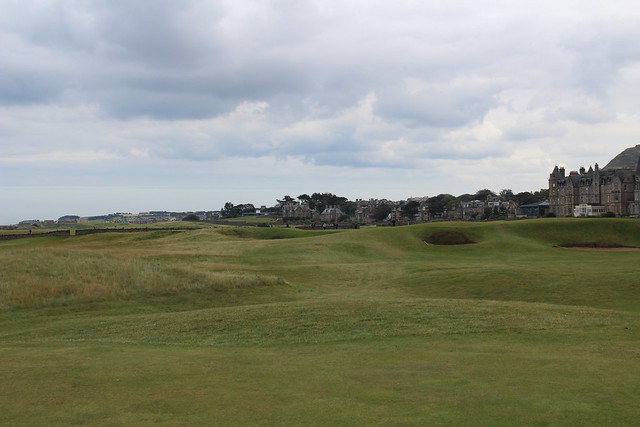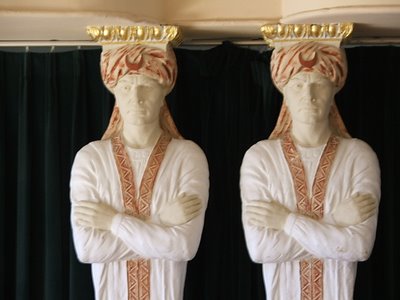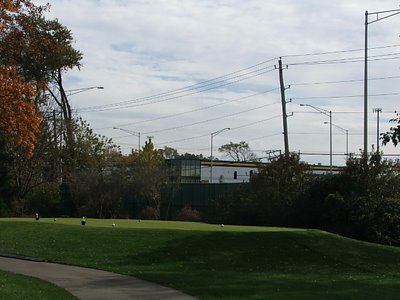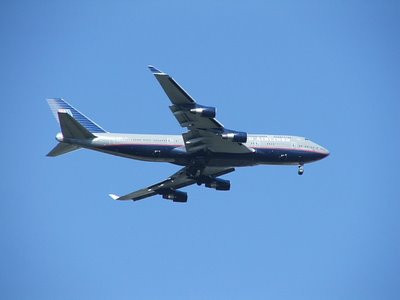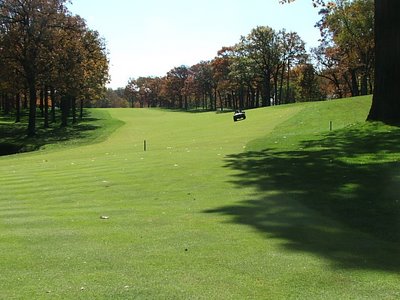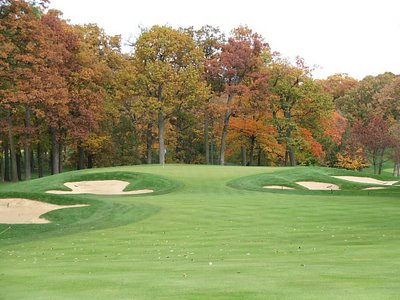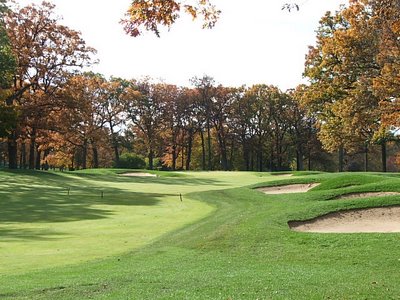Two of the unquestionably best golf courses in the world, both located in Scotland, are curiously not ranked in the world's top 100. North Berwick, located a couple of miles south of Muirfield on the east coast and Prestwick, located immediately adjacent to Royal Troon on the west coast.
Perhaps it is because the courses are too short - Prestwick is 6,554 yards and North Berwick 6,420. Or perhaps because they don't host championships any more, they are overlooked. Or perhaps those that rank the courses for the magazines sadly underweight history and tradition.
Both courses were clearly great 100 years ago. The famous British amateur champion of that era, Horace Hutchinson, wrote at the time - "A man is less likely to be contradicted in lauding Prestwick than in singing the praises of any other course in Christendom." The question is, are they still great courses today?
If you like courses with a lot of cement cart paths or if you like Donald Trump over-hyped golf courses, you won't appreciate these so you can stop reading now. If, however, you are a student of the game, appreciate tradition and want to have some of the best golfing experiences of your lifetime, I highly recommend both courses.
Prestwick Golf Club
Prestwick Golf Club, founded in 1851 is the birthplace of the Open Championship (British Open). The first Open was held at Prestwick in 1860 and was won by Old Tom Morris. Prestwick hosted the first 12 Open Championships and in total has hosted 24 Opens, second only to The Old Course at St. Andrews.
Playing at Prestwick is like going back in time. The course has a timeless feel to it and is hallowed ground for golfers.
Perhaps it is because the courses are too short - Prestwick is 6,554 yards and North Berwick 6,420. Or perhaps because they don't host championships any more, they are overlooked. Or perhaps those that rank the courses for the magazines sadly underweight history and tradition.
Both courses were clearly great 100 years ago. The famous British amateur champion of that era, Horace Hutchinson, wrote at the time - "A man is less likely to be contradicted in lauding Prestwick than in singing the praises of any other course in Christendom." The question is, are they still great courses today?
If you like courses with a lot of cement cart paths or if you like Donald Trump over-hyped golf courses, you won't appreciate these so you can stop reading now. If, however, you are a student of the game, appreciate tradition and want to have some of the best golfing experiences of your lifetime, I highly recommend both courses.
Prestwick Golf Club
Prestwick Golf Club, founded in 1851 is the birthplace of the Open Championship (British Open). The first Open was held at Prestwick in 1860 and was won by Old Tom Morris. Prestwick hosted the first 12 Open Championships and in total has hosted 24 Opens, second only to The Old Course at St. Andrews.
Playing at Prestwick is like going back in time. The course has a timeless feel to it and is hallowed ground for golfers.
The first hole at Prestwick is one of the world's great starting holes, even to this day. It is a short par four at only 346 yards. The name of the hole is Railway, and it is aptly named. You tee off about 10-15 steps from the clubhouse, usually with caddies or other players watching. It is also not uncommon to have members sitting in the smoke room who are also watching through a large picture window. As is typical in Britain, since there is no driving range, you have to hit your tee shot without warming up. The right side of the hole is out of bounds from tee to green since a railroad line runs down the coast toward Turnberry. Between you and the railway there is a stone wall the entire length of the hole. Making the hole even more difficult is the fact that the left side of the fairway is protected by a large swath of gorse bushes, taking away the potential strategy of playing to the left. It is a good test to see if you are on your game, hitting an iron under these conditions. I rank it among the top three first holes in the world (the other two being the opening tee shots at Merion and The Old Course at St. Andrews).
The British golf writer Henry Longhurst has said of the first at Prestwick - "A tremendous wind is blowing and the slightest letting up will see your ball sailing away like a seagulls feather across the down platform of Prestwick station."
The British golf writer Henry Longhurst has said of the first at Prestwick - "A tremendous wind is blowing and the slightest letting up will see your ball sailing away like a seagulls feather across the down platform of Prestwick station."
The first green at Prestwick
Horace Hutchinson also wrote extensively about the first - "The crime against which we have to chiefly be on our guard is that of slicing. There is apt to be an engine snorting loudly on the other side of the wall just as we are playing a critical and curly putt and the said putt is none easier from the engine having liberally besprinkled the green with cinders."

Fortunately, the trains are now all electric so we don't have to contend with cinders. But the sensation of playing the first hole remains with the modern golfer. Dell Leigh wrote eloquently about Prestwick's first hole in 1925, "Caddies, who have carried the clubs of champions, lean on the iron railings of their pen behind, taking stock of you. All along your right (or slicing hand), in terrible proximity, runs the railway line, over which rush whistle-blasting engines. Was it not Vardon who put his first two balls out of bounds on these same railway lines, and won the championship in spite of that?. Even if you play warily to the left here you have a grimly narrow opening to the green, and you are off the line of entry."

Fortunately, the trains are now all electric so we don't have to contend with cinders. But the sensation of playing the first hole remains with the modern golfer. Dell Leigh wrote eloquently about Prestwick's first hole in 1925, "Caddies, who have carried the clubs of champions, lean on the iron railings of their pen behind, taking stock of you. All along your right (or slicing hand), in terrible proximity, runs the railway line, over which rush whistle-blasting engines. Was it not Vardon who put his first two balls out of bounds on these same railway lines, and won the championship in spite of that?. Even if you play warily to the left here you have a grimly narrow opening to the green, and you are off the line of entry."
Detractors of Prestwick will tell you that they don't like the course because you can hit an iron off too many tees and granted, the eighteenth hole is a weak finishing hole. They will criticize the blind par three fifth hole, named Himalayas. The critics are wrong in my view. The place is worthy of being ranked among the top golf courses in the world. I will guarantee that you will think about Prestwick long after the memory of other courses fade. The sixteenth green, "Cardinal's Back":
It is interesting to note that when early American golf aficionados came to study the courses of The British Isles, among the courses they studied were Prestwick. Charles Blair Macdonald replicated two of the holes at Prestwick in his ideal golf course - The National Golf Links of America: the third hole, Cardinal, and the seventeenth, Alps. While some holes at Prestwick haven't stood the test of time, these two most certainly have. Both are excellent risk/reward holes that demand well played shots over difficult and massive bunkers.
The Alps hole is built on such a massive scale, it remains better than all attempts to copy it around the world. The seventeenth is seen greenside, below:
Pete Dye was also influenced by Prestwick where apparently he was inspired by the railway sleepers (ties as we call them in America) used to shore up bunkers. The course remains an important place in the history of the game and for this reason architects continue to study it.
Prestwick also allows you to appreciate its history to the fullest extent possible. If you book in advance, you can have lunch in the member dining room, shown below. You must wear a jacket and tie, and the hastle of changing into them is worth the trouble. You sit at a long table that seats 32 with dozens of pictures of past club captains in the dark green room. After lunch you can enjoy a Kummel (nasty) and a cigar as you contemplate your afternoon round and subliminally think - don't slice off that first tee.

North Berwick Golf Links
Similar in many respects to Prestwick, the West Links at North Berwick is an old, traditional golf course in the links style, founded in 1832. It is home to the most copied golf hole in history: the 15th hole at North Berwick is the original Redan hole. A Redan hole is a long par three (this one is 192 yards) that has a large bunker in front of the green and a deep bunker beyond the short side of the green. The green generally slopes from front-right to back-left. It is a hole that is approached diagonally and is quite difficult. At least 15 courses ranked in the top 100 have a Redan hole and I have heard often about how various Redan holes are better than the original. I don't agree with any of it. The original is the best.
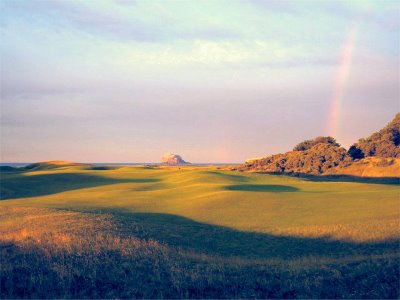
One of the defining features of the North Berwick West Links are the stone walls that are throughout the course. In several instances you have to hit your shots over the stone walls. On the 13th hole, a stone wall protects the green. If you hit your shot to the right (wrong?) spot on this hole you will have to either chip or putt off the green through an opening in the stone wall. It is a lot of fun.
The sixth hole is also a very good one. It is a short par four where more likely than not you will be hitting your second shot from a downhill lie, over a small burn to a green that slopes down to a burn that is hidden to the golfer off the tee.
The 16th hole, close to The Marine Hotel, which looms over the course from a promontory nearby, has one of the most interesting greens you will ever encounter. The green is bisected by a gully which creates two distinct tiers that are separated from one another. If your ball is on the wrong side of the gully, you will have a miniature-golf style putt. Think it's silly? It's not, it's a blast.
Hutchinson captured the essence of North Berwick and it still rings true today - "It is an exceptionally good school in which to learn the art of approaching." Clearly, at 6,420 yards, driving is not of paramount importance, but hitting good and often creative approach shots, is.
North Berwick, like Prestwick, does have some weak holes, most notably the first and finishing holes. Its detractors will tell you that it is not a good test of golf. No doubt, these detractors have never played the course when the wind is up, which is the real defense of links courses. There are few places in the world to play like North Berwick that are magical and will inspire you to keep going out again and again to play.

One of the defining features of the North Berwick West Links are the stone walls that are throughout the course. In several instances you have to hit your shots over the stone walls. On the 13th hole, a stone wall protects the green. If you hit your shot to the right (wrong?) spot on this hole you will have to either chip or putt off the green through an opening in the stone wall. It is a lot of fun.
The 2nd fairway at North Berwick is indicative of the course's contours
The sixth hole is also a very good one. It is a short par four where more likely than not you will be hitting your second shot from a downhill lie, over a small burn to a green that slopes down to a burn that is hidden to the golfer off the tee.
The hole every golfer loves, the 13th, with the green set beside a stone wall. Crazy, but fantastic!
The Redan hole from the tee. The puzzled golfer will be excused for standing on the tee scratching their head, dumbfounded on where to hit the ball
As you approach the green, you see what what you couldn't from the tee. Pray that you are not in the bunker left which is at least 15 feet deep and a true test of skill
The 16th hole, close to The Marine Hotel, which looms over the course from a promontory nearby, has one of the most interesting greens you will ever encounter. The green is bisected by a gully which creates two distinct tiers that are separated from one another. If your ball is on the wrong side of the gully, you will have a miniature-golf style putt. Think it's silly? It's not, it's a blast.
Grab your ankles if you're ball is not in the right spot on the 16th green
Hutchinson captured the essence of North Berwick and it still rings true today - "It is an exceptionally good school in which to learn the art of approaching." Clearly, at 6,420 yards, driving is not of paramount importance, but hitting good and often creative approach shots, is.
North Berwick, like Prestwick, does have some weak holes, most notably the first and finishing holes. Its detractors will tell you that it is not a good test of golf. No doubt, these detractors have never played the course when the wind is up, which is the real defense of links courses. There are few places in the world to play like North Berwick that are magical and will inspire you to keep going out again and again to play.
North Berwick Golf Club Web Site
Prestwick Golf Club Web Site
Credits: The sensational pictures with the sun shining in this posting that capture the spirit of North Berwick are from Golf Club Atlas.



